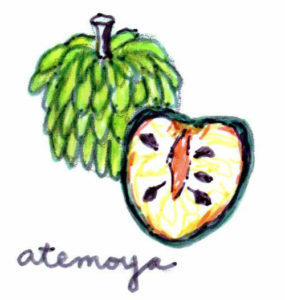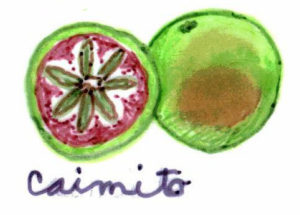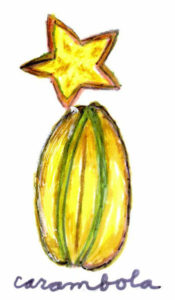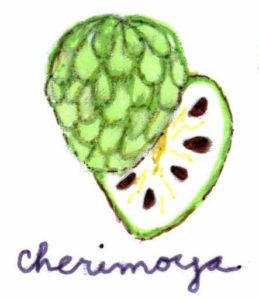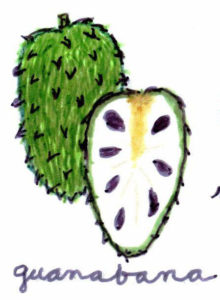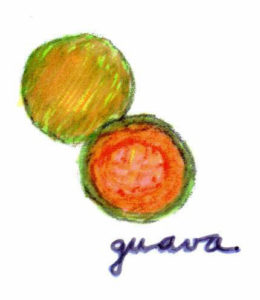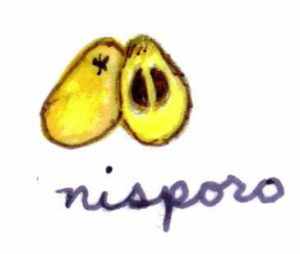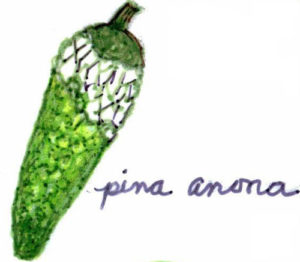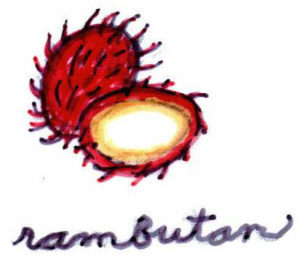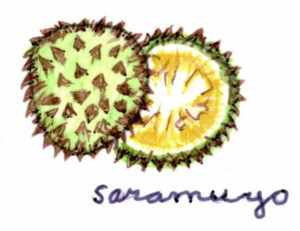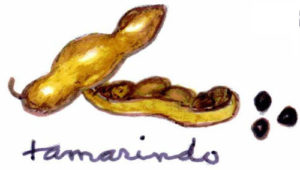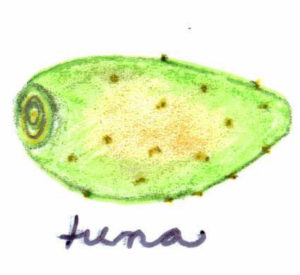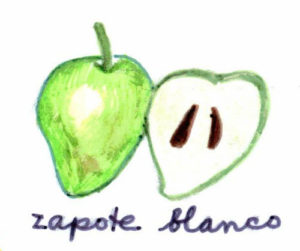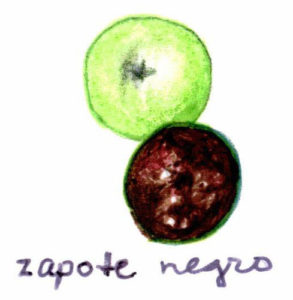Mexico is blessed with an abundance of fresh tropical fruit. Beautifully arranged platters of fruit are served in restaurants, and disposable cups or bags of fruit on street corners. No matter how humble the setting, these street-corner offerings are always cut into attractively uniform strips or wedges and served with a squeeze of fresh lime juice and powdered chile if desired.
Mexicans are large consumers of fruit and, as if there weren’t enough of a variety in the enormous selection of Mexican produce in the mercados and supermarkets, they also import from other countries. (Mexico and Canada are the largest consumers of California kiwis.) Many kinds of fruit, like papayas and bananas, are available year round; others are seasonal. But because of the warm, moist growing climate in the coastal regions that produce most of the tropical fruit, there are sometimes two seasons for one kind of fruit. With some fruit, such as the guava, this has now been extended to year round production. Others, like the mango, are in the markets only from spring to fall, making summer the ideal time to explore their many salsa, dessert and drink possibilities. Some of the tropical fruits that do so well in Mexico, like the lychee and the banana, were brought from South Asia via the Manila galleons, and thrived in the similar climate of Southern Mexico.
While mangos, papayas, pineapples and melons are all found in supermarkets north of the border, look for an increasing array of the more exotic varieties of tropical fruit in well-stocked produce sections. They can also be ordered online from www.melissas.com and www.proflowers.com. In addition to fruit plates and salads, use just about any of them in aguas frescas, licuados, smoothies, sorbets and sherbets. For those with ice cream makers, they are a great summer addition to the repertoire of flavors. They also make tasty fillings for dessert crepes; and don’t forget fruit salsas, great accompaniments to summer’s grilled dishes, especially chicken and fish. (For a selection of fruit salsa recipes, see Adding Zest to Summer’s Bounty.)
Tropical fruit should be allowed to ripen at room temperature, and once it is ripe should ideally be eaten immediately; if not, it may be stored in the refrigerator for up to three days. Nearly all of it is a good source of vitamin C, vitamin A, potassium and phosphorus. The fruits are listed below in alphabetical order by their Spanish names (the names you’ll hear in Mexican markets) followed by English and Latin botanical names. The recipes that follow are generally adaptable to several different kinds of fruit, so have fun and get creative.
Aguacate: avocado (Persea americana)
Native to Mexico, the avocado is available year round, although its peak months are late May to March. It is used in guacamole and salads, and the aromatic leaves are used to flavor bean dishes and mixiotes. An article with more information and recipes, The Avocado: On Beyond Guacamole can be found in the July/August 2003 issue of Mexico Connect.
Atemoya: manmade hybrid of chirimoya and saramuyo (both described below)
This fruit starts to appear in August, and in warm climates is sometimes found through January. Its scaly exterior contains sweet, creamy white flesh. Like all fruit in the anona family, the seeds should be avoided since they contain a slightly toxic substance, sometimes used in Mexico as an insecticide. It can be cut in half and eaten with a spoon, used in fruit salads or pureed and used to make ice cream.
Caimito or cainito: star apple (Chrysophyllum cainito)
A regional fruit in the Valladolid area of the Yucatan, related to the mamey and other sapote species, caimito is used in ices and ice cream. The stickiness of its pulp makes it advisable to puree the fruit and mix it with other ingredients, such as the cream in ice cream.
Carambola: starfruit (Averrhoa carambola)
Native to Southeast Asia, the carambola is now cultivated in Mexico, where it can be found in gourmet produce sections and some markets. The shape of the slices, when cut horizontally, is that of a five-pointed star. The flesh is sweet, crisp and golden yellow. Carambola makes a very attractive substitute for pineapple in an upside down cake which, when turned out of the pan, reveals the star-shaped slices.
Chirimoya: anona or custard apple (Annona cherimola)
The green armor-like skin of this fruit, like that of most anonas, is cut open to reveal a sweet, custardy white flesh. Used in ice cream and ices, the chirimoya makes a nice sauce for topping desserts, pancakes and waffles.
Chicozapote: sapodilla (Manilkara sapota)
Native to the Yucatan and southern Mexico, the chicozapote is one of the favorite tropical fruits in Mexico. The small (2″-4″) round-to-oval fruit is has a rough brown skin and dark, sweet pulpy fruit. It is commonly mixed with a bit of orange juice and honey and used as a spread on toast, and is also a favorite ingredient in mousse.
Coco: coconut (Cocos nucifera)
Available year round, coconuts are grown in Mexico’s warm coastal region and used all over the country, both fresh and dried. Used in ice cream and desserts, coconut also goes well in many salads and main courses, and has a special affinity for shrimp. The “milk” of fresh coconuts is actually more like water, and is said to be the best remedy for dehydration due to extreme heat.
Granada: pomegranate (Punica granatum)
Introduced by the Spaniards, pomegranate became an essential part of Mexico’s patriotically red-white-and green chiles en nogada, with the red color provided by pomegranate seeds, which are contained in the spherical, hard-skinned fruit. Pomegranate juice is used in savory sauces and salad dressings as well as sorbets and drinks. For more on pomegranates, including recipes, see Pomegranates: September’s Gift to Mexican Cuisine.
Granada china: golden passion fruit or granadilla (Passiflora ligularis)
Sometimes incorrectly translated as “passion fruit” because it is related, the granada china does not taste much like a true passion fruit, although its unique flavor and consistency are much prized by aficionados, who call it “the caviar of fruits.” An egg-shaped fruit with a hard yellow-orange “shell” is cut open to reveal a soft, grayish pulp, which is eaten right out of the shell with a spoon. Despite the hard outer skin, it is more perishable than most other tropical fruit, and is generally not used in ice cream and other confections. Granada china can be tested for ripeness by shaking it for the sound of the ripe flesh moving inside.
Guanábana: soursop (Annona muricata)
A favorite in paleterías, or ice pop stores, the guanábana, a native of Mexico and Central America, has a leathery green skin covered with soft spines. Its fragrant white flesh is commonly used in aguas frescas and sorbets.
Guayaba: guava (Psidium guajava)
Native to tropical America, the guava is found in Mexican supermarkets year round, and in municipal markets in late summer and early fall, and again in early spring. A thin yellow skin contains flesh that varies in color from white to pink. Because of its high pectin content, it is a favorite for making jams, jellies and marmalades.
Limón: lime (Citrus aurantifolia)
A small key lime, this is used in aguas, ices and served as a garnish with many dishes. It is said to act as a deterrent to potential intestinal infections, and is squeezed liberally on many kinds of food, including other fruit.
Litchi: lychee (Litchi chinesis)
Another fruit of Asian origin, lychee is a member of the soapberry family. About the size of a large strawberry, the lychee has a rough, “bumpy” dark red skin with sweet white flesh that is used to make agua fresca.
Mamey: mamey sapote (Pouteria sapota)
This looks something like a small football, with rough brown skin that is cut open to reveal soft, sweet orange flesh surrounding a large black pit. Mamey is a favorite for licuados and ice cream, and the pit is used, along with cacao flowers, to make the Oaxacan drink tejate.
Mango: mango (Mangifera indica)
Perhaps the country’s most beloved fruit, which arrived from South Asia and found an enormous welcome in Mexico, mango is used in salsas, savory sauces for fish and poultry, and an endless variety of drinks and desserts. For more on mangos, including recipes, see Mexican Mangos: Fantastic Flavor and Big Business.
Maracuya: passion fruit (Passiflora edulis)
A relative of granada china and purple passion fruit, the maracuya has a hard, yellow shell that contains soft pulp, prized in Oaxaca as a flavoring for ices and drinks. It is commonly crushed and used as a mixer with the alcoholic beverage mescal.
Melón: cantaloupe (Cucumis melo) Another European import, this member of the cucurbitae family, which includes squash and cucumber, is an important commercial fruit crop in Mexico, where it is used in fruit salads, aguas and licuados.
Nanche: nanche (Byrsonima crassifolia)
A yellow, olive-size Latin American native with a sweet taste when ripe, nanche is used in Mexico to make ice cream and a brandy-based conserve that is a regional specialty of the Isthmus of Tehuantepec. Its distribution is usually limited to local markets.
Níspero: loquat (Eriobotrya japonica)
Another Asian transplant, the small (about 2″) oval yellow fruit contains a slightly acidic pulp, ranging in color from white to yellow-orange. It is particularly popular in Oaxaca, where it is made into jams, jellies and marmalade.
Papaya: papaya (Carica papaya)
Probably the most popular breakfast fruit in México, papaya is also a favorite licuado ingredient. Its peppery-flavored seeds are used in salad dressings and as a home remedy for stomach ailments. Papaya contains enzymes that are used in meat tenderizer.
Piña: pineapple (Ananas cornosas)
Grown in Mexico’s warm coastal lowlands, especially in Veracruz, pineapple is now a year-round favorite, used in savory as well as sweet dishes. For more information and recipes, see The Pineapple: Sweet Symbol of the Tropics.
Piña anona, cerimán de México: ceriman, fruit salad plant, Mexican breadfruit (Monstera deliciosa)
The fruit of an ornamental shrub native to Mexico and Guatemala, piña anona looks like a narrow, foot-long cucumber. Its thick green skin is covered with scales that individually fall off as the fruit ripens. The white, custard like flesh, described as tasting like a mixture of pineapple, mango and banana, is eaten fresh or made into jam or jelly, but should never be eaten until completely ripe.
Pitahaya: dragon fruit (Hylocereus undatus)
Dark red, spiny fruit of the organ cactus, this is used in savory sauces or eaten fresh. It is found in abundance in the Tehuacan area of southern Puebla state, home to many types of cacti.
Plátano: banana (Musa sapientum)
The eating banana, found in markets all over the country year-round, is used in fruit salads and licuados.
Plátano macho: plantain (Musa paradisiaca)
The cooking banana, usually used when the skin has several black patches, is often fried and served with rice, or made into a croquette filled with black beans.
Rambutan: rambutan (Nephelium lappaceum)
This Asian native, ranging in color from red to yellow, looks like a lychee with long hair. The leathery skin is peeled to reveal a sweet, translucent fruit, eaten fresh or used to make agua.
Sandía: watermelon (Citrulius vulgaris)
This is eaten fresh or made into aguas or ices. It is a regular at street corner fruit salad stands.
Saramuyo: sugar apple or sweetsop (Annona squamosa)
This member of the anona family is found in markets of the Valladolid area of the Yucatan. It has the green, scaly skin typical of the anonas, with soft, sweet white pulp used in ices, ice cream and aguas.
Tuna: sweet prickly pear (Opuntia ficus indica)
The fruit of the nopal cactus, eaten raw or made into agua fresca. In the markets in Zacatecas, assorted colors of prickly pear fruit, from purple to green to white, are attractively arranged next to each other.
Xoconoxtle: sour prickly pear (Opuntia joconostle)
Another kind of opuntia fruit, this one tastes sour and is used as a seasoning in certain meat stews, especially mole de olla.
Zapote blanco: white sapote (Casimiroa edulus)
Native to central Mexico, the white sapote is more elongated than the other sapotes, shaped more like a pear, with green skin and white to yellowish white, sweet creamy pulp. It is eaten fresh or used in licuados.
Zapote Negro: black sapote or chocolate pudding fruit (Diospyros digyna)
Native along both coasts of Mexico, from Jalisco to Chiapas and from Veracruz to the Yucatan, this green-skinned sapote has soft, black, pudding- like flesh. It should be allowed to ripen until very soft and eaten like custard.

